- Best Cultivator Attachments Guide - December 23, 2021
- How to Find the Best Leaf Blower Attachment - December 23, 2021
- Best 21 Inch Lawn Mower Blade Options - December 18, 2021
If you are planning on making a garden in your yard, a tiller and a cultivator are among the essential tools you are going to need. But, your decision doesn’t boil down to cultivator vs tiller as these two gardening tools work together to ensure the soil is properly prepared for planting the seeds.
There is a lot of confusion regarding these two tools that is only heightened by machines that offer both the tilling and cultivating features.
In this article, we are going to take a closer look at the Troy-Bilt TB146 EC cultivator and the TACKLIFE TGTL02A Classic Tiller to help you better understand the differences between these tools.
Our cultivator vs tiller comparison will guide you through all of the most important features these gardening machines offer and provide you with information you need to decide which one of them best fits your gardening needs.
Main Differences Between a Cultivator and a Tiller
The main differences between a cultivator and a tiller are:
- A cultivator mixes the soil whereas a tiller breaks up hard soil
- A tiller cannot be used to aerate the soil, whereas a cultivator has the capability to aerate and loosen up the soil
- A cultivator is used frequently to maintain a garden, whereas a tiller is only used to create a garden plot
- A tiller is usually bulky and difficult to operate, whereas a cultivator is commonly lightweight and portable
- A cultivator doesn’t offer a lot of digging power, whereas a tiller can dig through the hardened soil effortlessly
- A tiller has a large engine and wide tines, whereas a cultivator has narrow tines and a relatively small engine
- A cultivator can be used to prevent weeds from growing, whereas a tiller is usually not used for this purpose
- A tiller may help you turn over a bygone crop once the season is over, whereas a cultivator doesn’t have the power to turn a crop over
Key specifications of a Cultivator and a Tiller
| Troy-Bilt TB146 EC | TACKLIFE TGTL02A Classic Tiller |
| Engine type: 29cc 4-cycle | Engine type: 12Amp pure copper motor |
| Tine width: 12 inches | Tine width: 16 inches |
| Tine depth: 8 inches | Tine depth: 5 inches |
| Fuel type: Gasoline | Fuel type: Powered by electricity |
| Weight: 36.6lbs | Weight: 25.9lbs |
| Dimensions: 32 x 18 x 18 inches | Dimensions: 17 x 14 x 22.7 inches |
| Latest price:Check the latest price here | Latest price: Check the latest price here |
Core features of a Cultivator and a Tiller
Finding a model that offers exclusively tilling or cultivating features may be more difficult than it seems. The reason for this is that tilling is considered a form of soil cultivation, as it is used to cultivate soil at a greater depth than a cultivator.
Hence you can use these machines to till the soil at the depth of 8 inches and then go through the cultivation process at the depth of 5 inches. This will enable you to break down hard patches of soil, remove roots, and prepare the soil for sowing seeds with the same tool.
We are going to take a closer look at the features of tools that are designed specifically for tilling and cultivating soil so that you can get a better overview of their capabilities.
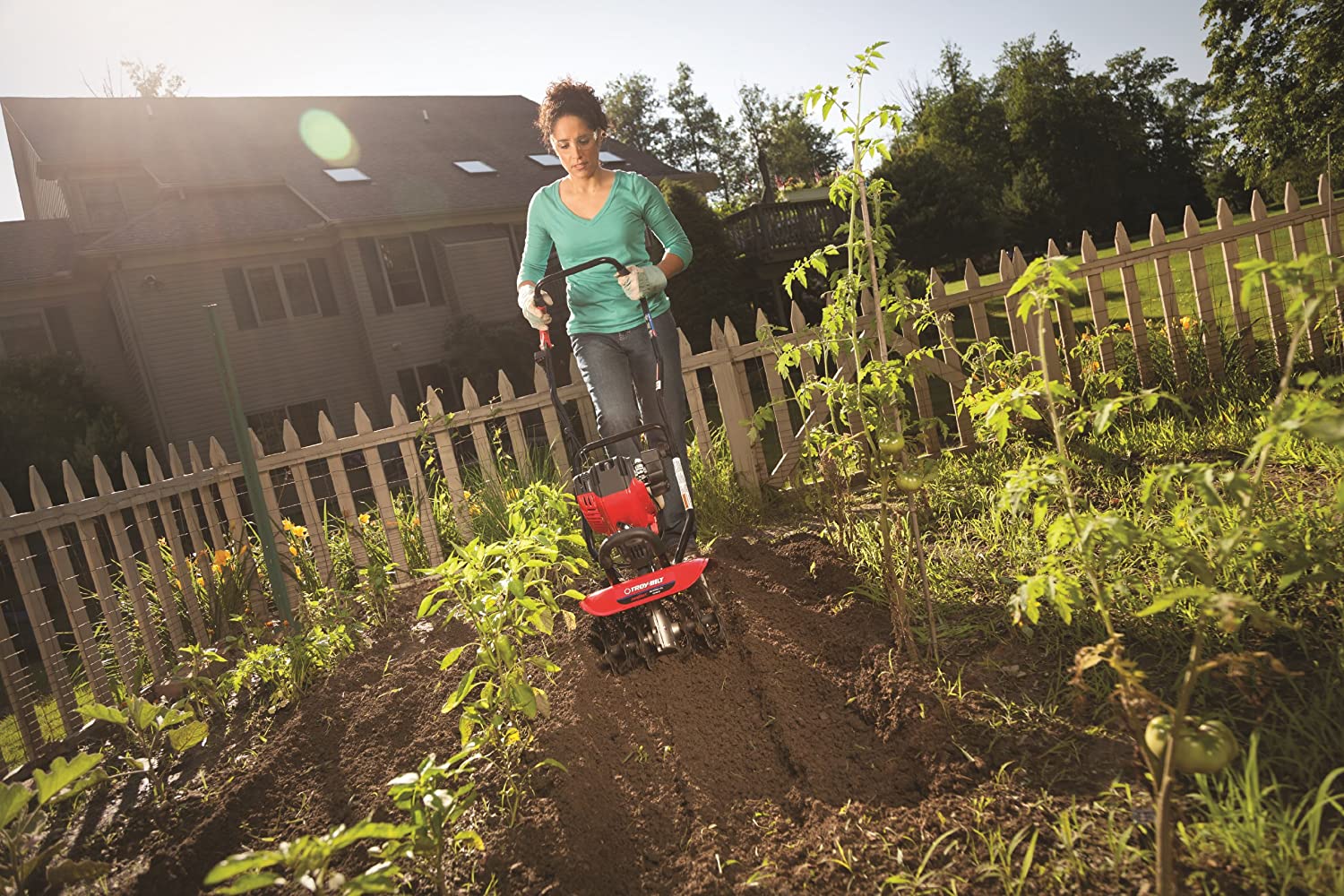
Different types of tillers
Although the market is saturated with gardening machines that combine the features of cultivators and tillers, there are still several different types of tools that are used exclusively for tilling or cultivating purposes.
For instance, the location of the tines on a tiller determines the size of the area on which you can use the tool.
The more common front-tine tillers, like the TAKCLIFE TGTL02A, have tines at the front end of the machine which makes them easier to maneuver, but they are only suitable for areas smaller than 1,500 square feet.
A rear-end tiller is more powerful and it can easily break up the soil on areas that are as large as 5,000 square feet. However, these models are considerably heavier than front-tine tillers and they are designed for industrial use.
The most common types of cultivators
Cultivators can either be powered by gasoline or electricity and the power source a particular model is using determines which type of cultivator it is.
A mini cultivator usually utilizes gasoline as fuel and it has three or more tines that are working simultaneously to loosen up the soil and mix the fertilizer into it. A model likeTroy-Bilt TB146 EC can have up to six tines that each contain as many as 8 blades.
Corded cultivators are primarily used for home gardening purposes, although they are as powerful as mini cultivators. However, the dependency on a stable source of electricity narrows down the range in which they can be used.
Design and durability
The design of cultivators and tillers is not very complicated as these tools contain a motor that powers the tines that loosen or mix the soil. They also feature ergonomic handles that enable you to maintain control over the tool while you are tilling or cultivating the soil.
The frame of a cultivator like the Troy-Bilt TB1346 EC is made of steel and it can withstand heavy-duty usage. The TAKCLIFE TGTL02A tiller is also designed with durability in mind as its components are made from sturdy materials that don’t break down easily.
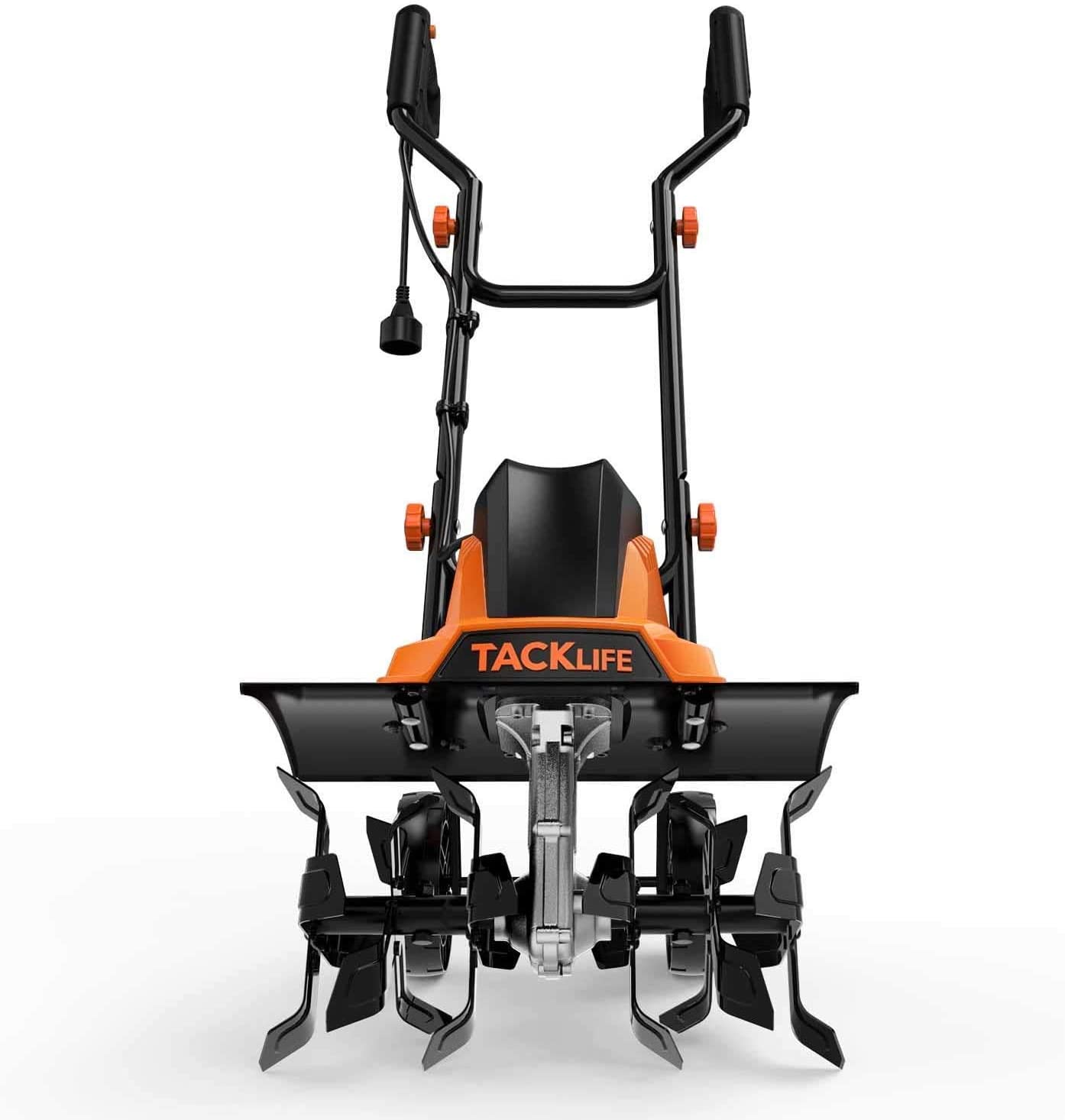
Engine types
The models that are powered by gasoline can either have 2-cycle or 4-cycle engines, and you should keep in mind that you will have to mix oil and gasoline on your own if you opt for a tiller or cultivator that has a 2-cycle engine.
An electric tiller like the TAKCLIFE TGTL02A utilizes a 12 Amp pure copper motor that can rotate the tines at speeds up to 400 rpm. It also secures enough torque to grind through dry soil or thick roots while keeping the noise and vibrations at a low level.
The 29cc 4-cycle engine, the Troy-Bilt TB1346 EC uses also produces a minimum amount of noise or vibrations, and it enables you to adjust the throttle speed.
This model utilizes the conventional recoil start system but it is compatible with the JumpStart™ engine starter that lets you start the tool by pushing a button.
This unit, however, isn’t powerful enough to break up hard soil and you can only use it to prepare and turn the soil at the beginning and the end of the season.
Tine depth and width
These two features are probably the most important factors you need to consider while choosing a tiller or a garden cultivator, as they determine how much ground you can grind or mix in one go or how deep the tine can go into the soil.
The TACKLIFE TGTL02A has tines with six manganese steel blades that provide the maximum tilling depth of 8 inches. The model’s tines are 16 inches wide which makes them perfectly suited for breaking new ground and preparing the soil for further cultivation.
However, its tine width is not adjustable and it may be difficult to remove weeds between rows in your garden with this tool. The maximum depth of the Troy-Bilt TB1346 EC’s six tines is just 5 inches which makes it ill-suited for breaking new ground and cutting through roots.
This cultivator lets you adjust its 8-inch forward-rotating tines width within the 6 to 12-inch radius so that you can use it for a variety of gardening tasks.
The size and weight
The purpose for which tillers are used commands a rugged construction, as these tools often have to tackle resilient roots or rocky patches of soil. However, the size or weight of a tiller doesn’t always reflect its performance capabilities.
The TACKLIFE TGTL02A tiller weighs just 25 pounds and it features double safety switches that prevent stones from injuring the user. A pair of wheels make maneuvering the tool easy, while an open armrest allows you to keep a firm grip on the tool.
This unit’s handle adjusts to the user’s height and it can be folded so that it occupies less storage space. The Troy-Bilt TB1346 EC’s handle is also foldable but it doesn’t offer the height adjustment feature.
The cultivator weighs 36.6 pounds and it is slightly larger than the TAKLIFE’s tiller, but it’s wheels make it equally portable.
Maintenance and warranty period
How difficult and time-consuming the task of maintaining a tiller or cultivator is going to be, depends on the model you choose. If you opt for a cultivator like Troy-Bilt TB1346 EC that has a 4-cycle engine you will have to clean the fuel and air filters regularly.
Moreover, adding a fuel stabilizer to the cultivator during the winter months will safeguard it from damages that can be caused by severe weather conditions. Cleaning and lubricating the tines are also among the maintenance tasks you will have to perform frequently.
Maintaining the TACKLIFE TGTL02A tiller in good condition is somewhat easier as you don’t have to perform routine checks of the engine but you will still have to ensure that the tines are properly cleaned and lubricated.
The warranty period of a tiller or a cultivator depends on a manufacturer. For instance, Troy-Bilt offers a lifetime warranty for their tillers and cultivators, but TACKLIFE’s products come with a two-year warranty.
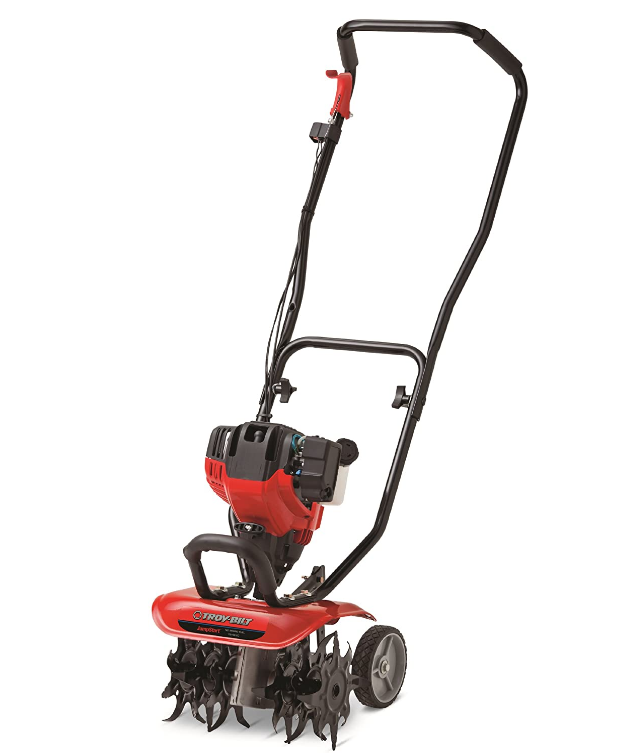
When to use a tiller and a garden cultivator
These tools are utilized during different stages of setting up a garden, as a tiller breaks up the soil and the cultivator creates a fine grind of soil that is suitable for planting seeds.
A tiller has sufficient power to handle thick roots and stones, while most cultivators struggle to perform this task. So, if you want to create a new garden plot or simply prepare the ground for a vegetable garden you should first use a tiller.
Afterward, you can utilize a cultivator to break up larger chunks of soil produced during the tilling process. A cultivator enables you to protect your garden from weeds throughout the summer season or prepare the ground for the winter season.
However, you should bear in mind that neither of these tools is designed to be used during the cold months of the year.
Cultivator VS Tiller – The Price
You won’t have to spend more than several hundred dollars on a cultivator or a tiller even if you are looking for a high-end model.
However purchasing the tools that offer only tilling or cultivating features can drain your budget, especially because tillers are rarely used more frequently than once per year.
TACKLIFE’s TGTL02A tiller is affordable and you won’t have to spend much more than a hundred dollars on it, while a cultivator like Troy-Bilt TB1346 EC can cost you a few hundred dollars.
Also, tiller-cultivator combo machines are available in a broad price range, and finding the model that fits your budget shouldn’t be too difficult.
Cultivator VS Tiller – Pros and Cons
TACKLIFE TGTL02A
Pros
- 8-inch tilling depth
- Powerful 12 Amp motor can develop 400 rpm speed
- 16-inch tilling width
- Equipped with a pair of wheels that increase its portability
- Features a mudguard and a safety system that prevents injury
- Features On/Off trigger for easy starting
- Adjustable handle length
- Minimal storage space requirements
Cons
- Doesn’t perform well in narrow spaces
- Power cord limits its range
- Short warranty period
- The tilling width is not adjustable
Troy-Bilt TB1346 EC
Pros
- Features an integrated grab bar for easy transportation
- Doesn’t require mixing of oil and fuel
- Each tine has 8 blades
- Equipped with six forward-rotating tines
- Built from sturdy materials
- SpringAssist technology make the recoil starting system more efficient
- Adjustable tine width
- Ships with a lifetime warranty
Cons
- More expensive than models with similar features
- High maintenance requirements
- JumpStart™ engine starter must be purchased separately
- Weighs more than thirty pounds
The best alternatives to cultivator and tiller
Purchasing a tiller and a cultivator may be unnecessary unless you are planning on breaking up hard ground, loosening up rocky soil, or creating new gardening plots frequently.
A dual-function tool that offers tilling and cultivating features is a better and more affordable choice for homeowners that only have basic gardening needs.
We’ve selected a few tiller-cultivator tools to help you narrow down your choices and find the option that best suits your demands.
Earthwise TC70001
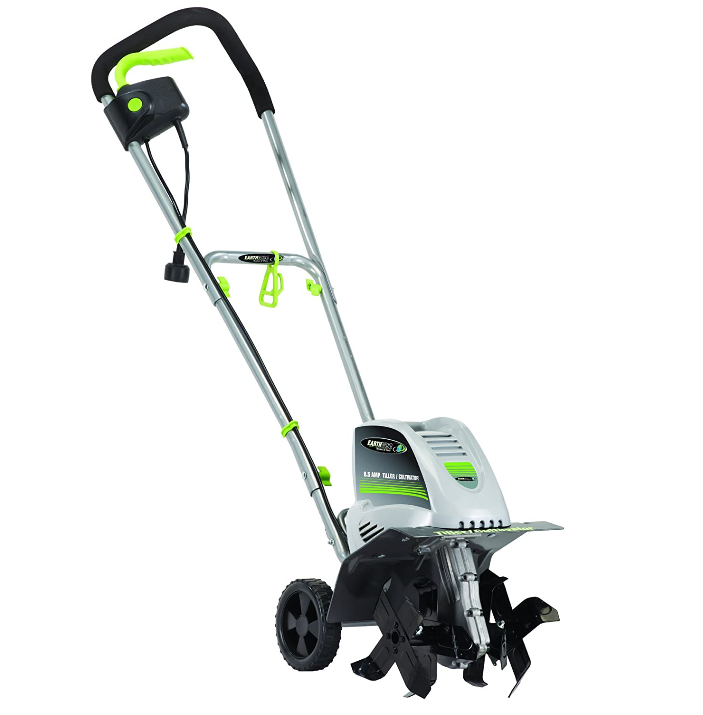
Like all electric tillers and cultivators, the Earthwise TC70001 is dependent on a stable power source, which makes it only a great fit for home gardening applications.
This tool allows you to break up the soil at a maximum depth of 8 inches, while its tines can cover the 11-inch area. The 8.5 Amp motor powers four heavy-duty tines that can help you cut through roots or mix the soil to ensure proper aeration.
This is an eco-friendly tool that doesn’t emit greenhouse gases and you can use it without having to worry about violating any regulations.
Sun Joe TJ601E Tiller Joe
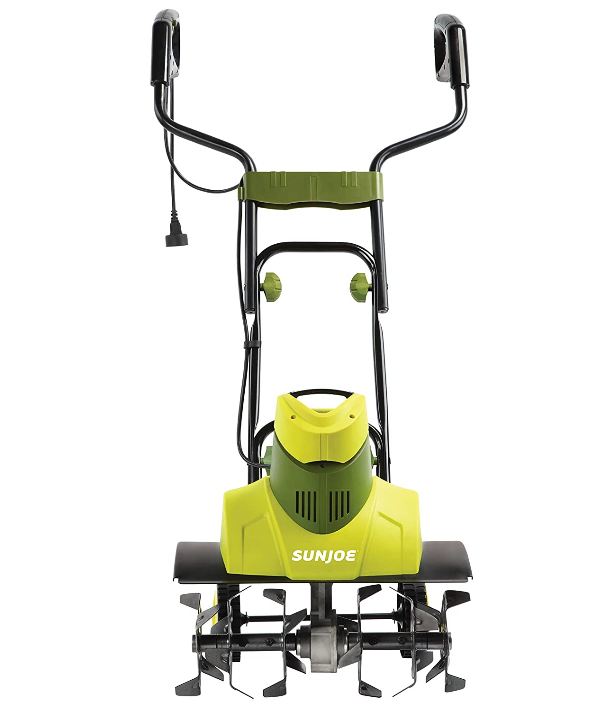
Creating flower beds or preparing small and medium-sized garden plots with the Sun Joe TJ601E Tiller Joe is an easy task. This dual-functionality tool has a 7-inch tilling capacity and it is equipped with 6 steel tines that can handle even the most challenging terrains.
The unit is powered by a 9 Amp motor and it offers an impressive 18-inch cultivating range. The wheels can be adjusted to seven different height positions so that you can choose the one that best fits the context in which you are using this tool.
This Sun Joe’s model comes with a two-year warranty that covers all failures of internal components or defects of the material.
Earthquake 20015
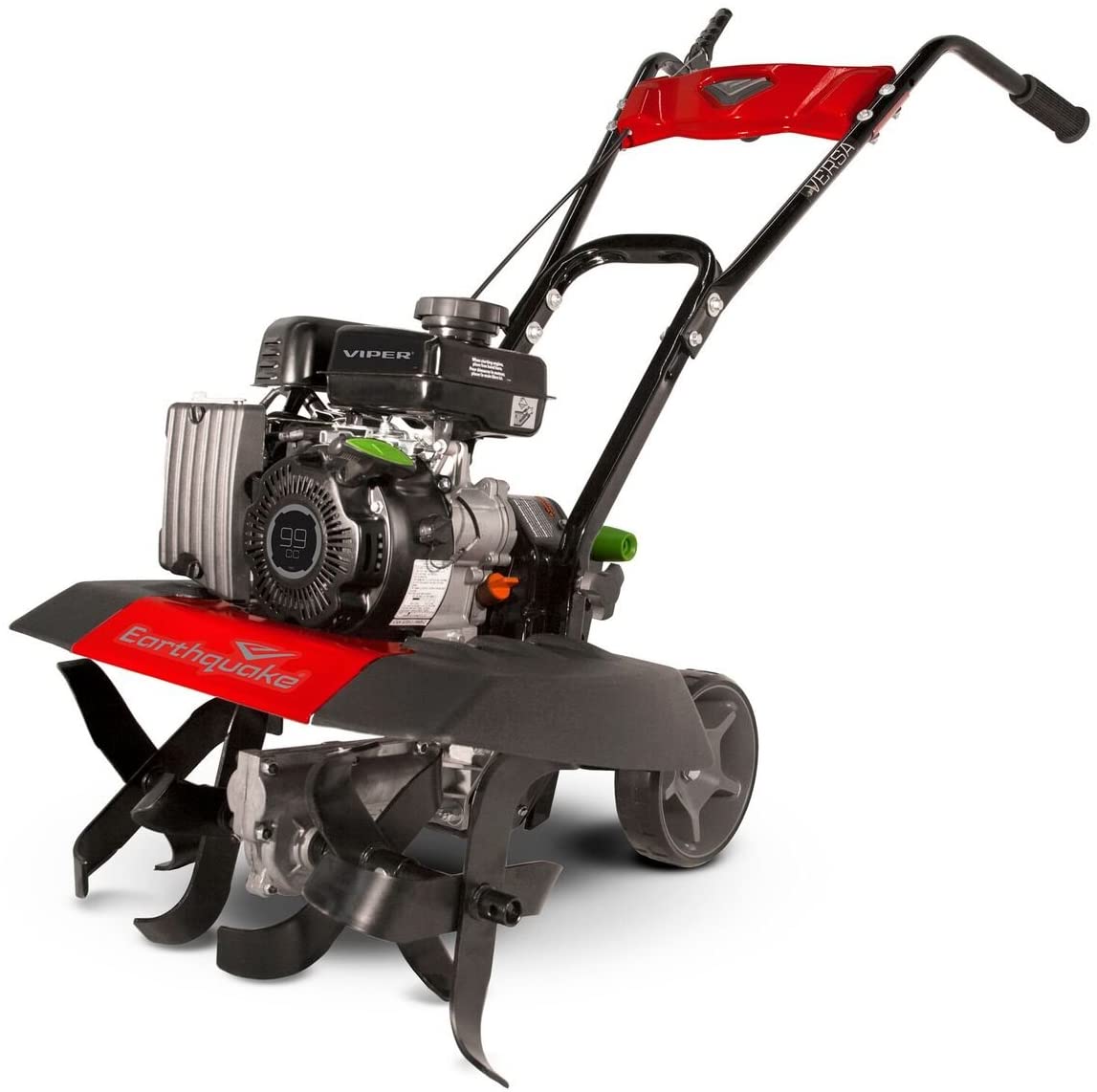
You can turn the Earthquake 20015 from a tiller into a cultivator by simply removing the outer tines. This tool is equipped with a 4-cycle 99cc engine that can produce up to 3.32 lb-ft of torque.
You can start this model by using its recoil system, and the engine will produce a minimum amount of noise and vibrations while it is operational. The Earthquake 20015 has an 11-inch tilling capability while it also lets you choose the tilling width.
This model enables you to choose if you want to mix soil at 11-inch, 16-inch, or 21-inch tilling widths. However, you should keep in mind that this tool weighs more than most tillers or cultivators on the market.
Frequently asked questions about cultivator and tiller
Tillers are usually used in early spring once the frost-free season has already started. The frosty ground can be too hard for a tiller and attempting to use it on frozen soil may damage the tool.
Tilling at the depth of 8 to 10 inches is considered ideal, and only a handful of models can offer a larger tilling depth.
You should cultivate your garden once you notice weeds or that the soil surface is crusted, but you should avoid cultivating while the soil is wet.
You should clean and oil the air filter on your cultivator after every ten hours of use. This means that a maintenance check should be performed at least twice a year.
The Verdict – Which gardening tool should you choose, a cultivator, or a tiller?
Ideally, a tiller and a cultivator should be used together during the process of setting up a new garden plot or a vegetable garden. A cultivator isn’t powerful enough to loosen hard soil which is the reason why a tool like TACKLIFE TGTL02A Classic Tiller can make this job much easier for you.
Once you’ve completed the tilling process, you can use the Troy-Bilt TB146 EC cultivator to mix and aerate the soil. However, tillers are not frequently used tools in home gardening, and spending hundreds of dollars on it can turn out to be a bad investment.
A dual-functionality tool like Earthquake 20015 is a more affordable option, as you can use its tilling capabilities alongside its soil cultivation features.
Hopefully, our cultivator VS tiller comparison provided you with all the information you needed to learn the difference between these two tools and chose the one that is better suited for your gardening needs. Leave a comment and let us know.

